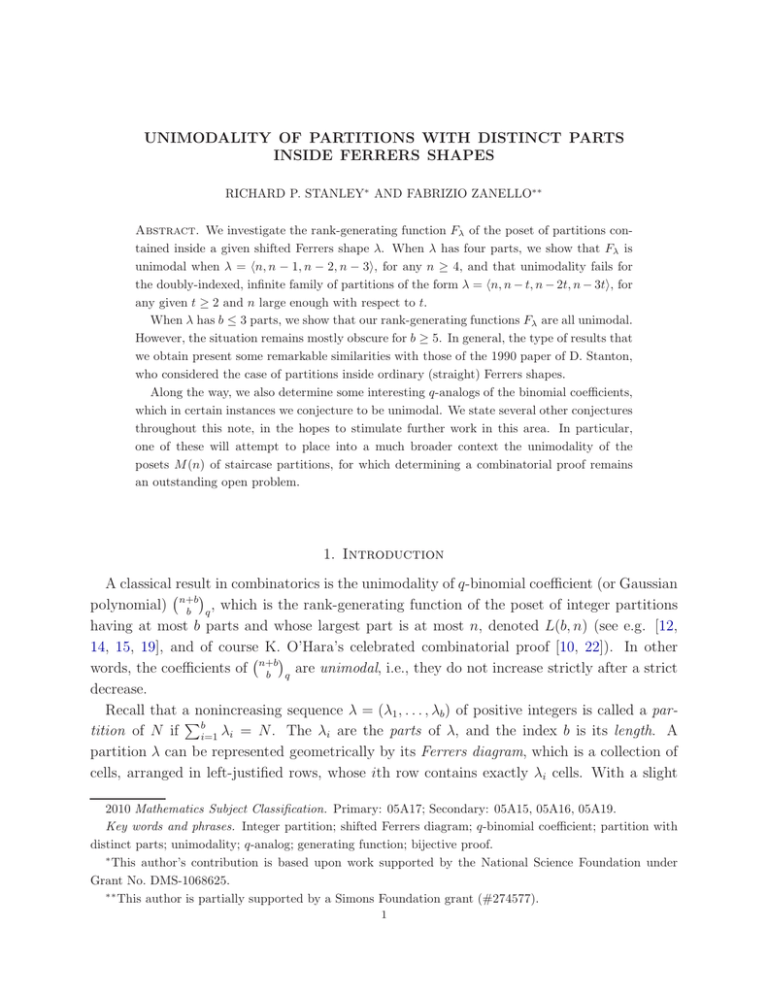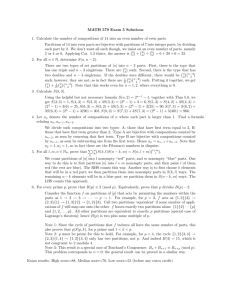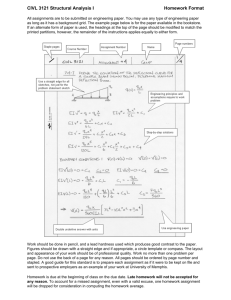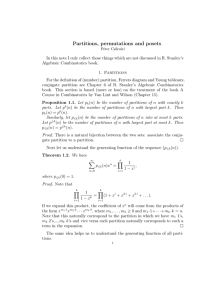UNIMODALITY OF PARTITIONS WITH DISTINCT PARTS INSIDE FERRERS SHAPES
advertisement

UNIMODALITY OF PARTITIONS WITH DISTINCT PARTS INSIDE FERRERS SHAPES RICHARD P. STANLEY∗ AND FABRIZIO ZANELLO∗∗ Abstract. We investigate the rank-generating function Fλ of the poset of partitions contained inside a given shifted Ferrers shape λ. When λ has four parts, we show that Fλ is unimodal when λ = hn, n − 1, n − 2, n − 3i, for any n ≥ 4, and that unimodality fails for the doubly-indexed, infinite family of partitions of the form λ = hn, n − t, n − 2t, n − 3ti, for any given t ≥ 2 and n large enough with respect to t. When λ has b ≤ 3 parts, we show that our rank-generating functions Fλ are all unimodal. However, the situation remains mostly obscure for b ≥ 5. In general, the type of results that we obtain present some remarkable similarities with those of the 1990 paper of D. Stanton, who considered the case of partitions inside ordinary (straight) Ferrers shapes. Along the way, we also determine some interesting q-analogs of the binomial coefficients, which in certain instances we conjecture to be unimodal. We state several other conjectures throughout this note, in the hopes to stimulate further work in this area. In particular, one of these will attempt to place into a much broader context the unimodality of the posets M (n) of staircase partitions, for which determining a combinatorial proof remains an outstanding open problem. 1. Introduction A classical result in combinatorics is the unimodality of q-binomial coefficient (or Gaussian polynomial) n+b , which is the rank-generating function of the poset of integer partitions b q having at most b parts and whose largest part is at most n, denoted L(b, n) (see e.g. [12, 14, 15, 19], and of course K. O’Hara’s celebrated combinatorial proof [10, 22]). In other words, the coefficients of n+b are unimodal, i.e., they do not increase strictly after a strict b q decrease. Recall that a nonincreasing sequence λ = (λ1 , . . . , λb) of positive integers is called a parP tition of N if bi=1 λi = N. The λi are the parts of λ, and the index b is its length. A partition λ can be represented geometrically by its Ferrers diagram, which is a collection of cells, arranged in left-justified rows, whose ith row contains exactly λi cells. With a slight 2010 Mathematics Subject Classification. Primary: 05A17; Secondary: 05A15, 05A16, 05A19. Key words and phrases. Integer partition; shifted Ferrers diagram; q-binomial coefficient; partition with distinct parts; unimodality; q-analog; generating function; bijective proof. ∗ This author’s contribution is based upon work supported by the National Science Foundation under Grant No. DMS-1068625. ∗∗ This author is partially supported by a Simons Foundation grant (#274577). 1 2 RICHARD P. STANLEY AND FABRIZIO ZANELLO abuse of notation, we will sometimes also denote by λ the Ferrers diagram of the partition λ. For some useful introductions and basic results of partition theory, we refer the reader to [2, 3, 11], Section I.1 of [9], and Section 1.8 of [16]. For any other standard combinatorial definition, we refer to [16]. The unimodality of the q-binomial coefficient can be rephrased in terms of Ferrers diagrams, by saying that the rank-generating function of the poset of partitions whose Ferrers diagrams are contained inside a b × n rectangle, namely Gλ , where λ = (λ1 = n, λ2 = n, . . . , λb = n), is unimodal. In his 1990 paper [18], D. Stanton studied the rank-generating function Gλ of partitions contained inside other Ferrers shapes λ. Not surprisingly, Gλ can be nonunimodal for certain λ, the smallest of which turned out to be λ = (8, 8, 4, 4). Stanton was also able to determine infinitely many nonunimodal partitions λ with b = 4 parts, while he proved that unimodality always holds when b ≤ 3. He also showed that nonunimodal partitions exist for b = 6, whereas all examples known to date when b = 5 or b ≥ 7 are unimodal. A well-known variant of the Ferrers diagram of a partition is the shifted Ferrers diagram of a partition λ with distinct parts. Such diagrams have λi cells in row i as before, but now each row is indented one cell to the right of the previous row. The goal of this note is to study the rank-generating functions Fλ of the posets of partitions µ contained inside a shifted Ferrers shape λ. Equivalently, µ is a partition with distinct parts contained in an ordinary (straight) Ferrers shape λ. We write hλ1 , λ2 , . . . , λn i for a partition λ with distinct parts, having at most n parts, regarded as a shifted diagram. Note that 0 is not considered a part, so λ = h4, 2, 1, 0, 0i is a partition with distinct parts. For instance, the partitions contained inside λ = h4, 2, 1i are: ∅ (the empty partition); h1i partitioning 1; h2i partitioning 2, h3i and h2, 1i partitioning 3; h4i and h3, 1i partitioning 4; h4, 1i and h3, 2i partitioning 5; h4, 2i and h3, 2, 1i partitioning 6; and h4, 2, 1i partitioning 7. Thus, Fh4,2,1i (q) = 1 + q + q 2 + 2q 3 + 2q 4 + 2q 5 + 2q 6 + q 7 . While Stanton’s work was in part motivated by the interest of the unimodality of rectangular Ferrers shapes, the corresponding prototype of partition in our situation is the “shifted staircase partition” λ = hb, b − 1, . . . , 2, 1i. The poset of partitions with distinct parts that it generates is often referred to as M(b). It is a standard exercise to show that Q Fλ (q) = bi=1 (1 + q i). The unimodality of this polynomial, which was essentially first proved by E.B. Dynkin [6, 7] (see also [12, 15]), is also closely related to the famous Erdös-Moser conjecture, solved by the first author in [15]. Notice, however, that the simplest proof known to date of the unimodality of the staircase partition uses a linear algebra argument [12]; it remains an outstanding open problem in combinatorics to determine a constructive proof. Though our situation is obviously essentially different from that of Stanton — for instance, it is easy to see that our rank-generating functions Fλ are never symmetric if λ has at least UNIMODALITY OF PARTITIONS WITH DISTINCT PARTS INSIDE FERRERS SHAPES 3 two parts, with the only exception of the staircase partitions — some of our results for distinct parts will show a remarkable similarity to the case of arbitrary partitions. In this paper we will mostly focus on partitions λ whose parts are in arithmetic progression, even though, similarly to what was done in [18], it is possible to naturally extend some results or conjectures to partitions having distinct parts that lie within certain intervals. In the next section, we will consider the case when λ has four parts. First, we show that Fλ is unimodal for all “truncated staircases” λ = hn, n − 1, n − 2, n − 3i. Notice that, unlike in many other instances of nontrivial unimodality results in combinatorics, in this case Fλ is never symmetric (for n > 4) nor, as it will be clear from the proof, log-concave. Our second main result is the existence of a doubly-indexed, infinite family of nonunimodal rank-generating functions Fλ . Namely, we will show that if λ = hn, n−t, n−2t, n−3ti, where t ≥ 2, then Fλ is always nonunimodal whenever n is large enough with respect to t (the least such n can also be computed effectively). For t = 2, as we will see in the subsequent section, . the rank-generating function Fλ turns out to be a q-analog of the binomial coefficient n+1 4 a q We will briefly discuss the meaning of these new q-analogs b . Interestingly, even though, unlike the q-binomial coefficient, in general they can be nonunimodal, we will conjecture q q and 2n . unimodality for our central q-binomial coefficients, 2n+1 n n Similarly to Stanton’s situation, we will also show that Fλ is unimodal for any partition λ with at most b = 3 parts (in fact, we will rely on Stanton’s theorem to give a relatively quick proof of our result). Moreover, again like Stanton, we are unaware of the existence of any nonunimodal rank-generating function Fλ when b = 5 or b ≥ 7, and will provide examples of nonunimodal Fλ for b = 6 that we have not been able to place into any infinite family. Next we conjecture the unimodality of all partitions λ having parts in arithmetic progression that begin with the smallest possible positive residue. This conjecture, if true, would place the still little understood unimodality of the staircase partitions into a much broader context. Other conjectures are given throughout this note. 2. Partitions of length four In this section, we study the rank-generating functions Fλ of partitions λ of length four. We focus in our statements on partitions whose parts are in arithmetic progression, which is the most interesting case; i.e., we consider λ to be of the form λ = hn, n − t, n − 2t, n − 3ti. Notice, however, that certain arguments could naturally be applied to partitions whose parts lie inside suitable intervals, similarly to some of the cases studied by Stanton [18]. Our first main result of this section is that if λ = hn, n − 1, n − 2, n − 3i, then Fλ is unimodal, for any n ≥ 4. In contrast, our second result will show that the doubly-indexed, infinite family of partitions λ = hn, n − t, n − 2t, n − 3ti are nonunimodal, for any given t ≥ 2 and n large enough with respect to t. The proofs of both results will be mostly 4 RICHARD P. STANLEY AND FABRIZIO ZANELLO combinatorial, and rely in part on the following elegant properties of the coefficients of the q-binomial coefficients a+4 , which are of independent interest. 4 q P i Lemma 2.1. Let a+4 = 4a i=0 da,i q . Define f (a, c) = da,2a−c − da,2a−c−1 for c ≥ 0, and 4 q f (a, c) = 0 for c < 0. (Hence, f (a, c) = 0 for c > 2a.) We have: (a) X a,c f (a, c)q a tc = 1 q 2 t2 + ; (1 − q 2 )(1 − q 3 )(1 − qt2 ) (1 − q 2 )(1 − q 3 )(1 − qt2 )(1 − qt) (b) f (a, c) ≥ 0 for all a and c. Moreover, if a ≥ 2 and 0 ≤ c ≤ 2a, then equality holds if and only if c = 1, c = 2a − 1, or (a, c) = (4, 3); (c) f (a, 0) = ⌊(a + 3δ)/6⌋, where δ = 1 if a is odd, and δ = 2 if a is even. In particular, f (a, 0) goes to infinity when a goes to infinity. Proof. (a) See Theorem 2.2 of [17]. (b) That f (a, c) ≥ 0 for all a and c is obvious from part (a) or also from the unimodality of the q-binomial coefficient a+4 . As for the second part of the statement, the fact that 4 q a a 2a−1 the coefficients of q t, q t and q 4 t3 are 0 for all a is easy to check directly. Proving the converse implication requires some careful but entirely standard analysis, so we will omit the details. (c) From part (a), we immediately have that the generating function for f (a, 0) is X 1 f (a, 0)q a = . 2 3) (1 − q )(1 − q a≥0 In other words, f (a, 0) counts the number of partitions of a whose parts can only assume the values 2 and 3. That their number now is the one in the statement is a simple exercise that we leave to the reader. This completes the proof of the lemma. Remark 2.2. It is possible to give an entirely combinatorial proof of parts (b) and (c) of Lemma 2.1, using D. West’s symmetric chain decomposition for the poset L(4, a), whose rank-generating function is of course a+4 (see [20] for all details). However, the argument 4 q would be less elegant and require significantly more work than using part (a) of the lemma. On the other hand, the portions of the statement that will later suffice to show the nonunimodality of λ = hn, n − t, n − 2t, n − 3ti for t ≥ 2 and n large — namely that f (a, 1) = 0 for all a, and f (a, 0) goes to infinity when a goes to infinity — are easy and interesting to show using West’s result. Indeed, it is clear that in his decomposition of L(4, a) there exist no symmetric chains of cardinality three (one should only check that the cardinality of the chains Di,j defined at the middle of page 13 of [20] cannot equal 3, by how the indexes i and j are defined for the new chains on page 7). This immediately gives that f (a, 1) = 0, since, clearly, f (a, c) = 0 if and only if in West’s construction there exist no symmetric chains of cardinality 2c + 1. UNIMODALITY OF PARTITIONS WITH DISTINCT PARTS INSIDE FERRERS SHAPES 5 In order to show that f (a, 0) goes to infinity, notice that West’s proof implies that f (a, 0) is nondecreasing, since in the inductive step he makes an injection between the chains constructed for a − 1 and those for a. Thus, in the formula for the cardinality of ci,j at the middle of page 13 of [20], one can for instance choose a to be a multiple of 6, i = a/3, and j = 0. This easily shows the existence of an extra chain of cardinality 1 for those values of a which does not come from a − 1, and thus it suffices to make f (a, 0) go to infinity. (In fact, a little more work proves in this fashion all of part (3) of Lemma 2.1.) Theorem 2.3. Let λ = hn, n − 1, n − 2, n − 3i, where n ≥ 4. Then the rank-generating function Fλ is unimodal. Proof. In the case when the partitions lying inside λ = hn, n − 1, n − 2, n − 3i have three or four parts, by removing the staircase h3, 2, 1i from λ, it is easy to see that such partitions are in bijection with the arbitrary partitions contained inside a 4 × (n − 3) rectangle, whose rank-generating function is n+1 . In a similar fashion, when the partitions lying inside 4 q λ = hn, n − 1, n − 2, n − 3i have at most two parts, by removing the staircase h1i we can see that such partitions are enumerated by n+1 . 2 q From this, we immediately have that Fλ decomposes as: n+1 6 n+1 . +q (1) Fλ (q) = 1 + q 4 2 q q We can assume for simplicity that n ≥ 8, since the result is easy to check (e.g., using Maple) for n ≤ 7. Let ci be the coefficient of degree i of q 6 n+1 . Hence, ci 6= 0 if and 4 q only if 6 ≤ i ≤ 4n − 6, and because of the unimodality of the q-binomial coefficient n+1 , 4 q the ci are also unimodal with a peak at c2n . Further, it easily follows from Lemma 2.1 that ci > ci−1 for all n + 1 ≤ i ≤ 2n, with the exception of i = 2n − 1, which gives c2n−1 = c2n−2 . On the other hand, notice that the q-binomial coefficient q n+1 is a unimodal function; 2 q its coefficients di are nonzero for 1 ≤ i ≤ 2n − 1, and they assume a peak at dn . Also, it is a simple exercise to check that when n+1 decreases (or by symmetry, it increases), it does 2 q so by at most 1. Finally, notice that d2n−1 = d2n−2 (they are both equal to 1), which implies that the coefficients of Fλ in degree 2n − 1 and 2n − 2 are also equal. Putting all of the above together, since by equation (1) Fλ can be written as Fλ (q) = 1 + 4n−6 X (ci + di )q i , i=1 it is easy to check that Fλ is unimodal. (In fact, we have shown that it has a peak in degree 2n.) Theorem 2.4. Let λ = hn, n−t, n−2t, n−3ti, where t ≥ 2 is fixed. Then the rank-generating function Fλ is nonunimodal for all integers n large enough with respect to t. 6 RICHARD P. STANLEY AND FABRIZIO ZANELLO P4n−6t t i ci q . We will prove that Fλ is nonunimodal for any t ≥ 2 and n Proof. Let Fλ (q) = i=0 large enough with respect to t, by showing that ct2n > ct2n−1 < ct2n−2 . We assume from now on that n is large enough. It is easy to see from Lemma 2.1 and the proof of Theorem 2.3 that c12n−1 = c12n−2 , and that c12n −c12n−1 goes to infinity. Indeed, we have shown in that proof that, in degree 2n, the rank-generating function of hn, n − 1, n − 2, n − 3i is the same as that of n+1 , whereas in degrees 2n − 1 and 2n − 2 it is exactly one more 4 q n+1 than that of 4 q , because of the extra contributions coming from q n+1 . 2 q 2 2 2 We begin by showing that c2n > c2n−1 < c2n−2 . Notice that the only partition of 2n that lies inside hn, n − 1, n − 2, n − 3i but not inside hn, n − 2, n − 4, n − 6i is hn, n − 1, 1i. Thus, c22n = c12n − 1. Similarly, the only partition of 2n − 1 that lies inside hn, n − 1, n − 2, n − 3i but not hn, n − 2, n − 4, n − 6i is hn, n − 1i, and therefore, c22n−1 = c12n−1 − 1. Finally, c22n−2 = c12n−2 , since all partitions with distinct parts of 2n − 2 that lie inside hn, n − 1, n − 2, n − 3i clearly cannot have n − 1 as their second largest part. It follows that the difference between (c12n , c12n−1 , c12n−2 ) and (c22n , c22n−1 , c22n−2 ) is (1, 1, 0), which immediately proves that c22n > c22n−1 < c22n−2 , i.e., the theorem for t = 2. In a similar fashion, it is easy to check that, in passing from hn, n − 2, n − 4, n − 6i to hn, n − 3, n − 6, n − 9i, the difference between (c22n , c22n−1 , c22n−2 ) and (c32n , c32n−1 , c32n−2 ) is (3, 2, 2), showing the result for t = 3. In general, if ni is the number of partitions of i into two distinct parts, employing the same idea as above easily gives us that in passing from hn, n − (t − 1), n − 2(t − 1), n − 3(t − 1)i to hn, n − t, n − 2t, n − 3ti, the difference ct2n − ct2n−1 decreases by n2t−3 − nt−2 with respect t−1 to ct−1 2n − c2n−1 . Notice that n2t−3 − nt−2 = ⌈(2t − 3)/2⌉ − ⌈(t − 2)/2⌉ = ⌊t/2⌋, if as usual we denote by ⌈x⌉ and ⌊x⌋ the smallest integer ≥ x and the largest ≤ x, respectively. P Therefore, the difference between c12n − c12n−1 and ct2n − ct2n−1 amounts to ti=1 ⌊i/2⌋, which has order of magnitude t2 /4. Since c12n − c12n−1 goes to infinity, this completes the proof that ct2n > ct2n−1 for all t ≥ 2 and n large enough with respect to t. Notice that c22n−1 < c22n−2 . Hence, in order to complete the proof of the theorem it now suffices to show that, in passing from hn, n − (t − 1), n − 2(t − 1), n − 3(t − 1)i to hn, n − t, n − 2t, n − 3ti, ct2n−1 decreases at least as much as ct2n−2 does, for any t ≥ 3. Thus, since n is large enough with respect to t, one moment’s thought gives that it is enough to show that there are at least as many partitions of 2n − 1 than there are of 2n − 2, which are contained inside hn, n − (t − 1), n − 2(t − 1), n − 3(t − 1)i and have n − (t − 1) as their second largest part. UNIMODALITY OF PARTITIONS WITH DISTINCT PARTS INSIDE FERRERS SHAPES 7 But if µ = hµ1 , µ2 = n−(t−1), µ3 , µ4 i is such a partition of 2n−2, notice that µ1 ≥ n−t+2, and therefore µ3 + µ4 ≤ 2n − 2 − (n − (t − 1)) − (n − t + 2) = 2t − 5, which is smaller than µ2 = n − (t − 1) by at least 2, since n is large. Therefore, we can define an injection between the above partitions of 2n − 2 and those of 2n − 1 by mapping µ to θ = µ + (0, 0, 1, 0). This shows that there are at least as many of the above partitions of 2n − 1 as there are of 2n − 2, which completes the proof of the theorem. Remark 2.5. The same idea of the proof of Theorem 2.4 can prove the nonunimodality of Fλ also for other partitions λ = hλ1 , λ2 , λ3 , λ4 i; namely, those that are obtained by “perturbing” hn, n−t, n−2t, n−3ti in a way that the λi remain within suitable intervals. This fact, which is quite natural, is also consistent with the results of Stanton [18] in the case of arbitrary partitions with parts lying within certain intervals. We only remark here that in general, however, an actual “interval property” (see e.g. [21]) does not hold in this context. In fact, it is easy to check, e.g. using Maple, that the rank-generating function Fλ is nonunimodal when λ = h19, 16, 11, 8i and λ = h19, 16, 9, 8i, while it is unimodal for λ = h19, 16, 10, 8i. 3. Other shapes q We begin by presenting a new q-analog of the binomial coefficients, that we call ab , for any integers a and b such that 1 ≤ b ≤ a/2. We will show that this q-analog is the rank-generating function Fλ of partitions with distinct parts contained inside λ = ha−1, a−3, . . . , a−(2b−1)i. After discovering an independent proof of this fact, we found out that it can also be easily deduced from a theorem of R. Proctor concerning shifted plane partitions (see [13, Theorem 1]). However, since our argument, unlike Proctor’s, is combinatorial, we include a sketch of it below for completeness. We use the following lemma without proof, since it is equivalent to the well-known fact that the number of standard Young tableaux with a boxes, at most two rows, and at most b boxes in the second row is ab . Lemma 3.1. Fix integers a and b such that 1 ≤ b ≤ a/2. Then the number of binary sequences of length a containing at most b 1’s, and such that no initial string contains more 1’s than 0’s, is ab . Proposition 3.2. Fix integers a and b such that 1 ≤ b ≤ a/2, and let λ = ha − 1, a − 3, . . . , a − (2b − 1)i. Then the number of partitions µ with distinct parts lying inside λ is ab . Proof. Let µ = hµ1 , . . . , µt i be a partition into distinct parts contained inside λ = ha − 1, . . . , a − (2b − 1)i. In particular, a − 1 ≥ µ1 > · · · > µt ≥ 1, where t ≤ b. We associate to µ a binary sequence of length a, say Wµ = wa wa−1 · · · w1 , such that wi = 1 if i is a part of µ, and wi = 0 otherwise. (Notice that wa is always 0, since a > µ1 for all partitions µ.) 8 RICHARD P. STANLEY AND FABRIZIO ZANELLO By definition, the number of 1’s in Wµ is t ≤ b, and since the parts of λ differ by exactly 2, it is a standard exercise to check that the above correspondence is indeed a bijection between our partitions µ and those binary sequences Wµ where no initial string of Wµ contains more 1’s than 0’s. Thus, by Lemma 3.1, the number of partitions µ is ab , as desired. Therefore, from Proposition 3.2 we immediately have the following result. q Corollary 3.3. If λ = ha − 1, a − 3, . . . , a − (2b − 1)i, then Fλ (q) = ab . For example, Fh8,6,4,2i q 5 Fh4,2i = = 1 + q + q 2 + 2q 3 + 2q 4 + 2q 5 + q 6 2 q 6 Fh5,3i = = 1 + q + q 2 + 2q 3 + 2q 4 + 3q 5 + 2q 6 + 2q 7 + q 8 2 q 9 = = 1 + q + q 2 + 2q 3 + 2q 4 + 3q 5 + 4q 6 + 5q 7 + 6q 8 + 7q 9 + 8q 10 + 4 9q 11 + 10q 12 + 11q 13 + 12q 14 + 11q 15 + 11q 16 + 10q 17 + 7q 18 + 4q 19 + q 20 . q Notice that, for b > 1, our q-analog ab of the binomial coefficient ab is always different q from the Gaussian polynomial ab q (in fact, it is easy to show that ab is never symmetric for b > 1). While ab q is well known to be unimodal, the case t = 2 of Theorem 2.4 proves q that, in general, unimodality may fail quite badly for ab , even when b = 4. The smallest such nonunimodal example is q 10 = 1+q+q 2 +2q 3 +2q 4 +3q 5 +4q 6 +5q 7 +6q 8 +8q 9 +9q 10 +10q 11 +12q 12 +13q 13 Fh9,7,5,3i = 4 +15q 14 + 16q 15 + 17q 16 + 16q 17 + 17q 18 + 15q 19 + 14q 20 + 11q 21 + 7q 22 + 4q 23 + q 24 . However, we conjecture that the following fact is true, which is a special case of a conjecture that we will state later. Conjecture 3.4. Our q-analogs of the central binomial coefficients are all unimodal. That q 2n q is, 2n+1 and are both unimodal, for any n ≥ 1. n n For partitions with three parts, all rank-generating functions are unimodal. We will provide a bijective proof of this result, assuming the corresponding theorem of Stanton for arbitrary partitions ([18, Theorem 7]). Lemma 3.5 (Stanton). If λ is any arbitrary partition of length b ≤ 3, then the rankgenerating function Gλ is unimodal. P Lemma 3.6. Consider the partition λ = (p, r, s), and let G(p,r,s) (q) = p+r+s ai q i . We have: i=0 (1) If 2 ≤ p ≤ 2r + s, then ap−1 < ap : (2) If p = 1 or p ≥ 2r + s + 1, then ap−1 = ap and ai ≥ ai+1 for all i ≥ p − 1. UNIMODALITY OF PARTITIONS WITH DISTINCT PARTS INSIDE FERRERS SHAPES 9 Proof. Since the largest part of λ is p, notice that there is a natural injection φ between the set Ap−1 of partitions µ of p − 1 contained inside the Ferrers diagram of λ and the set of partitions θ in Ap , where θ = φ(µ) = µ + (1, 0, 0). Thus, for any λ = (p, r, s), we have ap−1 ≤ ap . Clearly, equality holds if and only if there exists no partition θ = (θ1 , θ2 , θ3 ) in Ap such that θ1 = θ2 , since these are the only partitions not in the image of the map φ. It is a standard exercise now to show that if p ≤ 2r +s, then there always exists a partition θ ∈ Ap such that θ1 = θ2 . Indeed, if p = 2r + s, then we can pick θ = (r, r, s); for p < 2r + s, one can for instance first decrease the value of s until it reaches 0 (i.e., until p is down to 2r), and then consider the partitions θ = (d, d, ǫ), where d decreases by 1 at the time and ǫ is either 0 or 1, depending on the parity of p. This proves part (1). In order to prove (2), notice that the case p = 1 is trivial, since here λ = (p, r, s) = (1, 1, 1). Thus let p ≥ 2r + s + 1. Then we have that no partition θ of p inside λ = (p, r, s) can satisfy θ1 = θ2 , since θ3 ≤ s, θ2 ≤ r, and therefore θ1 ≥ r + 1. Thus, this is exactly the case where ap−1 = ap , and in order to finish the proof of the lemma, now it suffices to show that ai ≥ ai+1 for all i ≥ p − 1. But this can be done in a symmetric fashion to the above argument, by defining a map ψ from Ai+1 to Ai such that β = ψ(α) = α − (1, 0, 0). Since p ≥ 2r + s + 1, it is easy to see that ψ is well defined and injective. Thus, ai ≥ ai+1 for all i ≥ p − 1, as we wanted to show. Theorem 3.7. If λ is any partition with length b ≤ 3, then the rank-generating function Fλ is unimodal. Proof. When b = 1 the result is obvious, and when b = 2 it is also easy to check. Indeed, this can be done directly, or by observing that if λ = hp + 1, ri, for some p ≥ r ≥ 1, then one promptly obtains that Fhp+1,ri (q) = 1 + qG(p,r) (q). Thus Fλ is unimodal, since G(p,r) (q) is unimodal by Lemma 3.5. Hence, let b = 3, and set λ = hp + 2, r + 1, si, where p ≥ r ≥ s ≥ 1. Clearly, any partition µ contained inside λ has at most three parts, and it is easy to see that those with at least two parts are in bijective correspondence with arbitrary partitions contained inside (p, r, s), by removing the staircase h2, 1i. From this, it follows that Fhp+2,r+1,si (q) = q 3 G(p,r,s)(q) + (1 + q + q 2 + · · · + q p+2 ). Therefore, since by Lemma 3.5, G(p,r,s)(q) is unimodal, we have that in order to prove the unimodality of Fhp+2,r+1,si (q), it suffices to show that if the coefficients of G(p,r,s) (q) coincide in degree p − 1 and p, then they are nonincreasing from degree p − 1 on. But this follows from Lemma 3.6, thus completing the proof of the theorem. 10 RICHARD P. STANLEY AND FABRIZIO ZANELLO For partitions λ with b ≥ 5 parts, the scenario becomes more and more unclear, and it again bears several similarities with Stanton’s situation for arbitrary partitions. For instance, when b = 5, all examples we have computed are unimodal, and for b = 6, while it is possible to construct nonunimodal partitions, we have not been able to place them into any infinite family. In particular, even the “truncated staircases” λ = hn, n−1, . . . , n−(b−1)i in general need not be unimodal when b < n. For instance, the rank-generating function Fλ is nonunimodal for λ = h15, 14, 13, 12, 11, 10i, λ = h17, 16, 15, 14, 13, 12i, and λ = h19, 18, 17, 16, 15, 14i, though this sequence does not continue in the obvious way. In fact, L. Alpoge [1] has recently proved, by means of a nice analytic argument, that the truncated staircases are all unimodal for n sufficiently large with respect to b, a fact that was conjectured in a previous version of our paper. Theorem 3.8 ([1]). Let λ = hn, n − 1, . . . , n − (b − 1)i. Then the rank-generating function Fλ is always unimodal for n large enough with respect to b. As we mentioned earlier, recall that for b = n, i.e., for the staircase partitions λ = hb, b − 1, . . . , 2, 1i, the unimodality of Fλ has already been established, though no combinatorial proof is known to date. The following conjecture attempts to place this result into a much broader context. Conjecture 3.9. The rank-generating function Fλ is unimodal for all partitions λ = ha, a − t, ..., a − (b − 1)ti such that t ≥ a/b. In other words, unimodality holds for all partitions with parts in arithmetic progression that begin with the smallest possible positive integer. Notice that, again similarly to Stanton’s situation of arbitrary partitions, all examples we have constructed of nonunimodal rank-generating functions Fλ have exactly two peaks. However, it seems reasonable to expect that nonunimodality may occur with an arbitrary number of peaks, though showing this fact will probably require a significantly new idea. Conjecture 3.10. For any integer N ≥ 2, there exists a partition λ whose rank-generating function Fλ is nonunimodal with (exactly?) N peaks. Finally, recall that a sequence (a0 , a1 , . . . , aN ) is flawless if ai ≤ aN −i for all i ≤ N/2. Though this property is not as well studied as symmetry or unimodality, several natural and important sequences in algebra and combinatorics happen to be flawless (see e.g. [4, 5, 8]). We conclude this section by stating the following intriguing conjecture. Conjecture 3.11. For any partition λ, the rank-generating function Fλ is flawless. 4. Acknowledgements The second author warmly thanks the first author for his hospitality during calendar year 2013 and the MIT Math Department for partial financial support. The two authors want to UNIMODALITY OF PARTITIONS WITH DISTINCT PARTS INSIDE FERRERS SHAPES 11 acknowledge the use of the computer package Maple, which has been of invaluable help in suggesting the statements of some of the results and conjectures. References [1] L. Alpoge: Proof of a conjecture of Stanley-Zanello, J. Combin. Theory Ser. A 125 (2014), no. 1, 166–176. [2] G. E. Andrews: “The theory of Partitions”, Encyclopedia of Mathematics and its Applications, Vol. II, Addison-Wesley, Reading, Mass.-London-Amsterdam (1976). [3] G. E. Andrews and K. Eriksson: “Integer Partitions”, Cambridge University Press, Cambridge, U.K. (2004). [4] M. Boij, J. Migliore, R. Mirò-Roig, U. Nagel and F. Zanello: “On the shape of a pure O-sequence”, Mem. Amer. Math. Soc. 218 (2012), no. 2024, vii + 78 pp.. [5] M. Boij, J. Migliore, R. Mirò-Roig, U. Nagel and F. Zanello: On the Weak Lefschetz Property for artinian Gorenstein algebras of codimension three, J. Algebra 403 (2014), no. 1, 48–68. [6] E. B. Dynkin: Some properties of the weight system of a linear representation of a semisimple Lie group (in Russian), Dokl. Akad. Nauk SSSR (N.S.) 71 (1950), 221–224. [7] E. B. Dynkin: The maximal subgroups of the classical groups, in: Amer. Math. Soc. Transl., Ser. 2, 6 (1957), 245–378. Translated from: Trudy Moskov. Mat. Obsc. 1, 39–166. [8] T. Hibi: What can be said about pure O-sequences?, J. Combin. Theory Ser. A 50 (1989), no. 2, 319–322. [9] I. G. Macdonald: “Symmetric Functions and Hall Polynomials”, second ed., Oxford Mathematical Monographs, The Clarendon Press, Oxford University Press (1995). [10] K. O’Hara: Unimodality of Gaussian coefficients: a constructive proof, J. Combin. Theory Ser. A 53 (1990), no. 1, 29–52. [11] I. Pak: Partition bijections, a survey, Ramanujuan J. 12 (2006), 5–75. [12] R. Proctor: Solution of two difficult combinatorial problems using linear algebra, Amer. Math. Monthly 89 (1982), no. 10, 721–734. [13] R. Proctor: Shifted plane partitions of trapezoidal shape, Proc. Amer. Math. Soc. 89 (1983), no. 3, 553–559. [14] R. Stanley: Unimodal sequences arising from Lie algebras, Combinatorics, representation theory and statistical methods in groups, 127–136; Lecture notes in Pure and Appl. Mathematics, Dekker, New York (1980). [15] R. Stanley: Weyl groups, the hard Lefschetz theorem, and the Sperner property, SIAM J. Algebraic Discrete Methods 1 (1980), no. 2, 168–184. [16] R. Stanley: “Enumerative Combinatorics”, Vol. I, Second Ed., Cambridge University Press, Cambridge, U.K. (2012). [17] R. Stanley and F. Zanello: Some asymptotic results on q-binomial coefficients, preprint. Available on the arXiv. [18] D. Stanton: Unimodality and Young’s lattice, J. Combin. Theory Ser. A 54 (1990), no. 1, 41–53. [19] J.J. Sylvester: Proof of the hitherto undemonstrated fundamental theorem of invariants, Collect. Math. papers, Vol. 3, Chelsea, New York (1973), 117–126. [20] D. West: A symmetric chain decomposition of L(4, n), European J. Combin. 1 (1980), 379–383. See also Stanford University report STAN-CS-79-763 (1979), 15 pp. [21] F. Zanello: Interval Conjectures for level Hilbert functions, J. Algebra 321 (2009), no. 10, 2705–2715. [22] D. Zeilberger: Kathy O’Hara’s constructive proof of the unimodality of the Gaussian polynomial, Amer. Math. Monthly 96 (1989), no. 7, 590–602. 12 RICHARD P. STANLEY AND FABRIZIO ZANELLO Department of Mathematics, MIT, Cambridge, MA 02139-4307 E-mail address: rstan@math.mit.edu Department of Mathematical Sciences, Michigan Tech, Houghton, MI 49931-1295 E-mail address: zanello@mtu.edu








